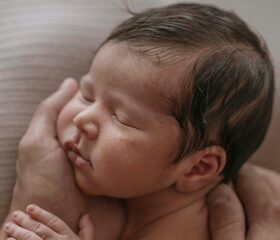Epstein Pearls: What the White Spots on Your Baby’s Gums Are
You might (understandably!) be alarmed if you find an odd bump inside your newborn’s mouth. Don’t worry; it’s most likely just an Epstein pearl.

These tiny white or yellow cysts are usually harmless and are actually quite common in newborns. Read on to learn what exactly Epstein pearls are and what causes babies to have them.
What are Epstein pearls?
Epstein pearls are small, round cysts that may form on your newborn’s gum line or the roof of his mouth. These benign bumps are filled with keratin, a protein found in skin, hair, and nails. 1
Epstein pearls typically range from 1 to 3 millimeters in size and can appear as singular bumps or show up in small clusters. 2
Your baby isn’t alone if he has Epstein pearls. Research shows that between 65% and 85% of newborns develop them. 2
What causes Epstein pearls?
Epstein pearls develop when layers of skin cells become trapped as the roof of the mouth (the palate) fuses together during fetal development. 2 The trapped cells fill with keratin and form small cysts. This process is entirely natural, and you can’t prevent it.
How to identify Epstein pearls and make sure they don’t need treatment
While Epstein pearls themselves are harmless and don’t need treatment, it’s possible to confuse them with other medical conditions that actually do need medical attention.
Here’s how to distinguish Epstein pearls from other issues.
What do Epstein pearls look like?
Again, Epstein pearls are small, white, or yellowish bumps. They’re usually firm to the touch and smooth and round in appearance. They often show up on the roof of your baby’s mouth (in the center) or along his gum line (although this location is much rarer).
The good news is that, unlike other oral conditions, Epstein pearls aren’t painful for your baby. Moreover, they won’t interfere with feeding or impact his future dental development. 1
Can Epstein pearls show up anywhere else on your baby’s body?
Epstein pearls are part of a group of cysts known as “newborn keratin cysts,” which can show up in different parts of the body. Their location is the only thing that sets them apart. 1
Along with Epstein pearls, your baby could have Bohn’s nodules, which show up as bumps on the lip or tongue side of his gums, more commonly on the upper jaw.
Dental lamina cysts (cysts that form from the remnants of specialized tissue that contribute to your baby’s tooth development) are another common keratin-based cyst. These harmless cysts usually form along your baby’s gums and might even resemble unerupted baby teeth. 1
How Epstein pearls compare to other conditions
While Epstein pearls are generally harmless, it’s easy to mistake them for other, more serious conditions.
Check out the table below to see how Epstein pearls compare to other oral and skin conditions: 2 3 4 5 6 7
| Condition | Characteristics |
|---|---|
| Bohn’s nodules | - Grayish cysts, usually found on the sides of the gums |
| Teething (generally occurs after 6 months) | - Uncomfortable swelling on the gums |
| Thrush | - White patches in your baby’s mouth with a “cottage cheese” texture, which can be wiped off - Transferred from mother to baby - Can cause fussiness while feeding |
| Hand, foot, and mouth disease | - Painful blisters in your baby’s mouth - Usually accompanied by fever and skin rashes on the palms of the hands and soles of the feet |
| Milia | - Tiny white cysts on your baby’s skin, on the nose or around the eyes (not in the mouth) |
| Natal teeth (teeth that babies are born with in rare circumstances) | - Firmer than Epstein pearls and can interfere with feeding |
| Abscesses | - White/gray or reddish blisters on the gum line - Painful - Grows rapidly |
Talk to your pediatrician if you’re unsure whether your baby has Epstein pearls or any of the other conditions mentioned above. When in doubt, it’s always better to get them checked out.
How long do Epstein pearls last?
Epstein pearls are harmless and will disappear on their own, usually within a few weeks of birth. 8 Your baby usually won’t need any treatment from your doctor, and, as mentioned, Epstein pearls won’t interfere with breastfeeding, bottle-feeding, or dental development.
What to do (and not do) about Epstein pearls
As mentioned earlier, Epstein pearls are temporary and resolve by 3 months old. There’s no need for active treatment.
In the meantime, here’s what you can do—and what you should avoid doing—about them:
- Don’t squeeze or pop them: No matter how tempted you may be, never squeeze or pop your baby’s Epstein pearls. Doing so is completely unnecessary and can introduce bacteria and cause your baby to get an infection. 1
- Avoid home remedies: Don’t use ointments, oils, or creams on the pearls. They won’t make them dissolve faster or help your baby’s healing.
- Don’t rub or scrape them: Much like popping and squeezing, rubbing or scraping Epstein pearls can only make things worse for your baby. Again, the best approach is to just leave them alone.
When to speak to your doctor about Epstein pearls
Although Epstein pearls are generally harmless, get on the phone with your pediatrician if: 1
- The cysts last longer than a few months
- Your baby is uncomfortable, in pain, or has difficulty feeding
- The bumps grow larger or otherwise change in appearance, or if new cysts appear
- Your baby has other unusual symptoms like bleeding, redness, or swelling
Final thoughts
Epstein pearls are a common, harmless part of newborn development that typically passes without intervention.
Knowing what these cysts are—and what they aren’t—has hopefully set your mind at ease. However, if you’re at all unsure, your pediatrician is always there to help you make sure everything’s on the level.
With a bit of patience, those tiny pearls will be gone before you know it.
Article Sources
- Cleveland Clinic. "Epstein Pearls" Retrieved August 19, 2025.
- StatPearls. "Palatal and Gingival Cysts of the Newborn" Retrieved August 19, 2025.
- MedlinePlus. "Teething" Retrieved August 19, 2025.
- MedlinePlus. "Thrush - children and adults" Retrieved August 19, 2025.
- Centers for Disease Control and Prevention. "About Hand, Foot, and Mouth Disease" Retrieved August 19, 2025.
- MedlinePlus. "Milia" Retrieved August 19, 2025.
- MedlinePlus. "Natal teeth" Retrieved August 19, 2025.
- MedlinePlus. "Epstein pearls" Retrieved August 19, 2025.







